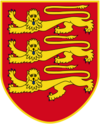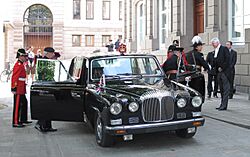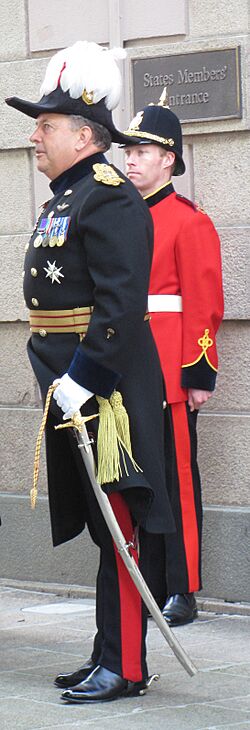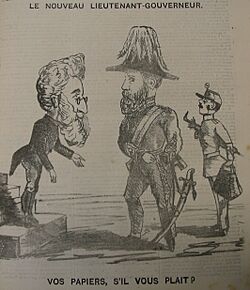Lieutenant Governor of Jersey facts for kids
Quick facts for kids Lieutenant Governor of Jersey |
|
|---|---|

Flag of the lieutenant governor of Jersey
|
|

Coat of arms of Jersey
|
|
| Style | His Excellency |
| Residence | Government House |
| Appointer | Monarchy of the United Kingdom |
| Term length | Five years |
| Formation | 1502 |
| First holder | Sir Hugh Vaughan (as Governor of Jersey) |
The Lieutenant Governor of Jersey (in Jèrriais: Gouvèrneux d'Jèrri, meaning "Governor of Jersey") is the person who represents the British monarch (currently King Charles III) in Jersey. Jersey is a special territory called a Crown Dependency, which means it belongs directly to the British Crown but is not part of the United Kingdom.
There isn't a separate "Governor of Jersey" anymore. That role's duties were taken over by the Lieutenant Governors and then stopped completely in 1854. Today, the Lieutenant Governor's job is mostly about ceremonies and representing the King. The daily running of the government is handled by the Chief Minister of Jersey. Other official matters, like legal issues, are overseen by the Bailiff of Jersey.
Contents
What Does the Lieutenant Governor Do?

The Lieutenant Governor acts like a head of state for Jersey. They perform many important ceremonial duties. They also help keep the connection strong between the governments of Jersey and the United Kingdom.
The Lieutenant Governor also has some duties related to citizenship. These include things like:
- Passports: Jersey passports are British passports. They are issued on behalf of the Lieutenant Governor.
- Deportation: The Lieutenant Governor formally orders when someone must leave Jersey.
- Nationality: They issue certificates for people becoming British citizens.
The Lieutenant Governor is also a member of the States of Jersey, which is Jersey's parliament. However, they cannot vote on laws. By tradition, they only speak in the parliament when they are appointed to the role and when they leave it.
A Look at History

The special role of the Lieutenant Governor comes from Jersey's unique history. The Channel Islands were once part of the Duchy of Normandy. When the Dukes of Normandy became Kings of England, these islands remained connected to the English Crown.
Even after England lost control of mainland Normandy, the Channel Islands stayed loyal to the English (and later British) monarch. They were governed separately from England.
- Early Leaders: From 933, the islands were directly controlled by the Dukes of Normandy and then the Kings of England.
- Delegated Power: Over time, the King started to delegate power to others. These people were called "lords of the isles" or "wardens of the isles." They had a lot of power to command and make judgments.
- The Bailiff's Role: Eventually, a separate position called the "bailiff" was created. The bailiff handled civil and legal matters.
After Jersey was occupied by the French from 1461 to 1468, the English Crown paid more attention to the island's defense. A "captain of the isles" was appointed. Later, these captains were called "governors."
- Defining Roles: In the early 1600s, there were disagreements between the governor and the bailiff about who was in charge. Rulings by the Privy Council decided that the governor would mostly handle military matters. The bailiff would be in charge of most civil and judicial duties.
After 1660, the role of Governor of Jersey became more of an honorary position. The actual duties were carried out by Lieutenant Governors. Since 1856, the Lieutenant Governor has officially represented the Crown in Jersey.
Over the years, the Lieutenant Governors have lost some of their powers:
- Customs Duties: Since 1921, the States of Jersey (the island's parliament) has controlled customs duties, not the Lieutenant Governor.
- Veto Power: The Lieutenant Governor used to be able to stop laws passed by the States of Jersey. This power was removed in 2005.
- Choosing Governors: Since 2010, a special group in Jersey helps choose future Lieutenant Governors, rather than ministers in the UK.
Former Governors of Jersey
Here are some of the people who served as Governor of Jersey:
| Date | Governor |
|---|---|
| 1470–1483 | Richard Harliston (Captain in Chief of Jersey) |
| 1486–1494 | Matthew Baker |
| 1494–1500 | Thomas Overay |
| 1500–1502 | Jean Lempriere |
| 1502–1531 | Sir Hugh Vaughan (first to be known as Governor) |
| 1532–1534 | Sir Anthony Ughtred |
| 1534–1536 | Sir Arthur Darcy |
| 1536–1537 | Sir Thomas Vaux, Lord Vaux |
| 1537–1550 | Sir Edward Seymour |
| 1550–1574 | Sir Hugh Paulet |
| 1547–1590 | Sir Amyas Paulet |
| 1590–1600 | Sir Anthony Paulet |
| 1600–1603 | Sir Walter Raleigh |
| 1603–1630 | Sir John Peyton |
| 1631–1643 | Sir Thomas Jermyn |
| 1644–1651 | Sir Henry Jermyn, 1st Earl of St Albans |
| 1651–1654 | Colonel James Heane |
| 1655–1659 | Colonel Robert Gibbon |
| 1659–1660 | Colonel John Mason |
| 1660 | Colonel Carew Raleigh |
| 1660–1665 | Sir Henry Jermyn, 1st Earl of St Albans |
| 1665–1679 | Sir Thomas Morgan, 1st Baronet |
| 1679–1684 | Sir John Lanier |
| 1684–1703 | Thomas Jermyn |
| 1704–1722 | General Henry Lumley |
| 1723–1749 | Richard Temple, 1st Viscount Cobham |
| 1749–1761 | Lieutenant General John Huske |
| 1761–1772 | George Keppel, 3rd Earl of Albemarle |
| 1772–1795 | Field Marshal Henry Seymour Conway |
| 1795–1796 | Field Marshal Sir George Howard |
| 1796–1807 | George Townshend, 1st Marquess Townshend |
| 1807–1820 | John Pitt, 2nd Earl of Chatham |
| 1820–1854 | William Beresford, 1st Viscount Beresford (Last Governor) |
Lieutenant Governors of Jersey
Here is a list of the Lieutenant Governors of Jersey:
| Title | Appointed | Name |
|---|---|---|
| 1634 | Sir Philippe de Carteret (Royalist) | |
| 26 August 1643 | Major Lydcott (Parliament) | |
| 24 November 1643 | Sir George Carteret (Royalist) | |
| at least by 1689 | Edward Harris | |
| 3 March 1695 | Col. Thomas Collier | |
| 29 July 1715 | Robert Wilson | |
| 1723 | Magnus Kempenfelt | |
| 23 October 1727 | Col. George Howard | |
| 1732 | Peter Bettesworth | |
| 1738 | Maj-Gen. Jean Cavalier | |
| 1741 | Francis Best | |
| 1747 | Gregory Beake | |
| 12 August 1749 | William Deane | |
| 26 June 1753 | George Colingwood | |
| Lieutenant Governor and Colonel on Staff: | 7 July 1770 | Lt-Col. Rudolph Bentinck (acting) |
| 4 April 1771 | Major Moses Corbet | |
| 6 January 1781 | Major Francis Peirson (acting) (killed in action, 6 January 1781) | |
| 5 October 1797 | Lt-Gen. Andrew Gordon | |
| 21 June 1806 | Gen. Sir George Don, GCB, GCH | |
| 8 October 1814 | Gen. Sir Tomkyns Hilgrove Turner, GCH | |
| 9 May 1816 | Lt-Gen. Hugh Mackay Gordon | |
| 23 July 1821 | Gen. Sir Colin Halkett, GCB, GCH, GCTE | |
| 26 November 1830 | Lt-Gen. Sir William Thornton, KCB | |
| 22 April 1835 | Maj-Gen. Archibald Campbell, CB | |
| 14 September 1838 | Lt-Gen. Sir Edward Gibbs, KCB | |
| 16 January 1847 | Maj-Gen. Sir James Henry Reynett, KCB, KCH | |
| 30 April 1852 | Gen. Sir James Frederick Love, GCB, KH | |
| 30 January 1857 | Maj-Gen. Godfrey Charles Mundy | |
| 18 September 1860 | Maj-Gen. Sir Robert Percy Douglas | |
| 5 October 1862 | B. Loch (acting) | |
| 23 October 1863 | Lt-Gen. Sir Burke Douglas Cuppage, KCB | |
| 1 October 1868 | Maj-Gen. Philip Melmoth Nelson Guy, CB | |
| 1 October 1873 | Lt-Gen. Sir William Sherbrooke Ramsay Norcott, KCB | |
| 1 October 1878 | Lt-Gen. Lothian Nicholson, CB | |
| 1 October 1883 | Maj-Gen. Henry Wray, CMG | |
| 1 November 1887 | Lt-Gen. Charles Brisbane Ewart, CB | |
| Lieutenant Governor and Commanding the Troops: | 1 November 1892 | Lt-Gen. Sir Edwin Markham, KCB |
| 10 May 1895 | Lt-Gen. Sir Edward Hopton, KCB | |
| 1 November 1900 | Maj-Gen. Henry Richard Abadie, CB | |
| 1904 | Maj-Gen. Hugh Sutlej Gough, CB, CMG | |
| 16 June 1910 | Maj-Gen. Sir Alexander Nelson Rochfort, KCB, CMG | |
| 7 October 1916 | Maj-Gen. Sir Alexander Wilson, KCB | |
| 29 October 1920 | Maj-Gen. Sir William Douglas Smith, KCB, KCVO | |
| 1924 | Maj-Gen. Sir Francis Richard Bingham, KCB, KCMG, JP | |
| 28 May 1929 | Maj-Gen. Edward Henry Willis, CB, CMG | |
| 28 May 1934 | Maj-Gen. Sir Horace de Courcy Martelli, KBE, CB, DSO | |
| 1939 | Maj-Gen. James Murray Robert Harrison, CB DSO | |
| (German Occupation 1940–1945) | ||
| Head of the British Military Government: | 12 May 1945 | L.A. Freeman |
| Lieutenant Governor and Commander-in-Chief: | 25 August 1945 | Lt-Gen. Sir Arthur Edward Grasett, KBE, CB, DSO, MC |
| 16 October 1953 | Adm. Sir Randolph Stewart Gresham Nicholson, KBE, CB, DSO, DSC | |
| 15 November 1958 | Gen. Sir George Erskine, GCB, KBE, DSO | |
| 15 January 1964 | Vice-Adm. Sir John Michael Villiers, KCB, OBE | |
| 30 June 1969 | Air Chf Mshl Sir John Gilbert Davis, GCB, OBE, MA | |
| 2 September 1974 | Gen. Sir Geoffrey Richard Desmond Fitzpatrick, GCB, DSO, MBE, MC | |
| 26 November 1979 | Gen. Sir Peter John Frederick Whiteley, GCB, OBE | |
| 9 January 1985 | Adm. Sir William Thomas Pillar, GBE, KCB | |
| 1990 | Air Mshl Sir John Matthias Dobson Sutton, KCB | |
| September 1995 | Gen. Sir Michael John Wilkes, KCB, OBE | |
| 24 January 2001 | Air Chf Mshl Sir John Cheshire, KBE, CB | |
| 1 April 2006 | Lt-Gen Sir Andrew Ridgway, KBE, CB | |
| 26 September 2011 | Gen. Sir John McColl, KCB, CBE, DSO | |
| 13 March 2017 | Air Chf Mshl Sir Stephen Dalton, GCB | |
| 8 October 2022 | Vce Adm Jerry Kyd, CBE |
The Lieutenant Governor's Flag
The Lieutenant Governor has a special flag in Jersey. It is the Union Flag (the flag of the United Kingdom) with Jersey's coat of arms added to it.
Where the Lieutenant Governor Lives
The official home of the Lieutenant Governor is Government House. It is located in St Saviour, Jersey. This building was even shown on the Jersey £50 banknote between 1989 and 2010.
See Also
- Bailiff of Jersey
- Lieutenant Governor of Guernsey



